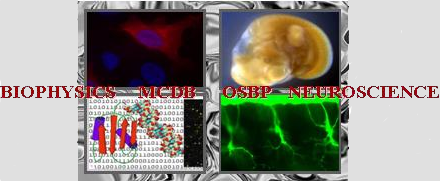Poster abstracts
Poster number 12 submitted by Tyler Billings
Native mass spectrometry reveals ATP-bound populations of Rho termination factor
Tyler D Billings (Ohio State Biochemistry Program), Kristie Baker (Department of Chemistry and Biochemistry), Philip Lacey (Department of Chemistry and Biochemistry), William Moeller (Department of Chemistry and Biochemistry), Vicki Wysocki (Department of Chemistry and Biochemistry), Mark P. Foster (Department of Chemistry and Biochemistry)
Abstract:
Hexameric helicases are essential motor proteins that unwind nucleic acid duplexes by converting the chemical potential of nucleotide triphosphates into translational motion. Several hydrolytic mechanisms have been proposed according to structural, biochemical, and single-molecule studies, with the rotary model of ATP hydrolysis emerging as the most suited to explain rapid, directional translocation.1 In one formulation of the rotary model, one site bearing no substrate, a second with ADP product, and a third with ATP substrate undergo catalytic turnover in a defined order: hydrolysis of ATP substrate in one site is coupled with release of ADP product in the preceding site while free ATP enters the empty site. The resulting sequential hydrolysis is coupled to conformational changes in RNA-binding loops located in the central pore of the helicase.
A requirement of the rotary mechanism is that six otherwise identical sites must coordinate nucleotide binding, hydrolysis, and product release. Previous studies using conventional bulk binding assays have suggested that strong, negative homotropic cooperativity in ATP binding results in rings that are not fully saturated even with many-fold stoichiometric excess of substrate.2 A drawback of indirect binding measurements is that the signal could be distorted by the allosteric effects that result in the observed cooperativity. We have used native mass spectrometry (nMS) to observe and quantify ATP binding to E. coli Rho factor as a model hexameric helicase. Unlike in bulk binding assays, nMS can directly measure each liganded population, thereby removing the confounding effects of allostery. Recording nMS spectra of Rho as a function of varying ATP concentrations allowed us to quantify populations of rings bound with differing numbers of ATP ligands. These populations can then be fit with mechanism-based thermodynamic models3 to learn about binding thermodynamics and the origin of the observed cooperativity. This information is crucial for understanding and testing models for ATP-driven translocation of Rho and related helicases.
References:
1. Fernandez, Amy J., and James M. Berger. “Mechanisms of Hexameric Helicases.” Critical Reviews in Biochemistry and Molecular Biology, vol. 56, no. 6, Nov. 2021, pp. 621–39. DOI.org (Crossref), https://doi.org/10.1080/10409238.2021.1954597.
2. Geiselmann, J., et al. “Physical Properties of the Escherichia Coli Transcription Termination Factor Rho. 1. Association States and Geometry of the Rho Hexamer.” Biochemistry, vol. 31, no. 1, Jan. 1992, pp. 111–21. PubMed, https://doi.org/10.1021/bi00116a017.
3. Li, Weicheng, et al. “Structural Basis of Nearest-Neighbor Cooperativity in the Ring-Shaped Gene Regulatory Protein TRAP from Protein Engineering and Cryo-EM.” bioRxiv: The Preprint Server for Biology, May 2024, p. 2024.05.02.592192. PubMed, https://doi.org/10.1101/2024.05.02.592192.
Keywords: native mass spectrometry, thermodynamics, helicase
